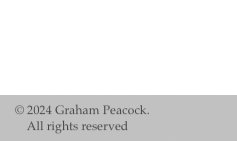|
Peacock's work a celebration of art
Abstract Painter inspired by colour
Author Unknown. Folio. March 27, 1992
Graham Peacock's (Art and Design) work celebrates the wonder and joy of art and the way it can give people pleasure. The abstract artist acknowledges that there are tragic events in the world that may have as much significance as the joyful events, but he's made a deliberate choice not to portray the darker side of life.
Professor Peacock is inspired by color and always has been. "In order to try to make color live, there's a need for clarity and light. In structuring color to produce that light and clarity, there seems to be a very positive assertion that goes with that process," he explains.
"It's very hard to paint for other people who have a diversity of interests and tastes. But in general, I would like them to be uplifted and to feel a sense of positive assertion and joy," says Professor Peacock, whose most recent paintings are showing at the Fine Arts Building Gallery until 29 March.
"I do it for my own quest; I need to create and extend my vision," says the 46-year-old who joined the University in 1969. His process is contemplative, reflective and responsive.
His paintings-some of which are massive accretions of a multitude of brilliant colors are freely created from the natural formations of loosely poured acrylic paint into canvas troughs,. suspended by support structures. The canvas is held in place by these supports to form what could be described as massive "pie plates". He's deliberate about his choice of colors and its composition.
He begins with a few colors. Several days later, he intuitively senses the possibility of using other colors. This process of "crazing" produces separations in the layers of paint. "The painting, for all of its planning, becomes an act of discovery, a hypothesis brought to a visual conclusion, a visual alchemy of adventure set in motion by my actions and under my control.
"It's very much like jazz. You have a basic melody, but you can interpret it."
The interpretive act is not complete yet, however. Cropping, shaping and undulating the painted canvasses results in the final expressive interpretations of the painting. An individual painting can take two or three months to complete.
Professor Peacock says some insight can be gained by having an appreciation for and understanding of the process involved. Like the ear, the eye has to be trained so that it can be used as more than just an "instrument of general navigation.
"The work has constantly evolved and grown since 1982 and I feel it is more whole than it's ever been," says Professor Peacock, adding that that is perhaps because "I've reached a state of eloquence in my life." In those earlier days, when the process was in its infantile stages, the shapes and patterns were fairly regular. That's given way to bolder and more textured images. "Hopefully, the next stage in the development of the work will add something else. The whole nature of the creative process is one of extending."
Asked whether outside forces in his life have helped to enhance the process, Professor Peacock says, "Life in general is a metaphysical experience and everything's interrelated. The way I work is quite metaphysical. The process is quite open from beginning to end to all sorts of interventions."
Professor Peacock, who was born in England and educated at Leeds College of Art, derives a great deal of stability from the support of his wife and four children and the fact that he has a full-time professorial position.
"It's easy to learn how to paint a good Matisse or Monet, because it's well within our focus and it's something that's been culturally absorbed. The area in which I work is on the cultural fringe," he says. In the heritage of painting, there's a whole sequence of artists who have evolved ways of working, he explains. "Those contribute to my way of working-yet the whole trick is to develop your own twists."
|
|
|



